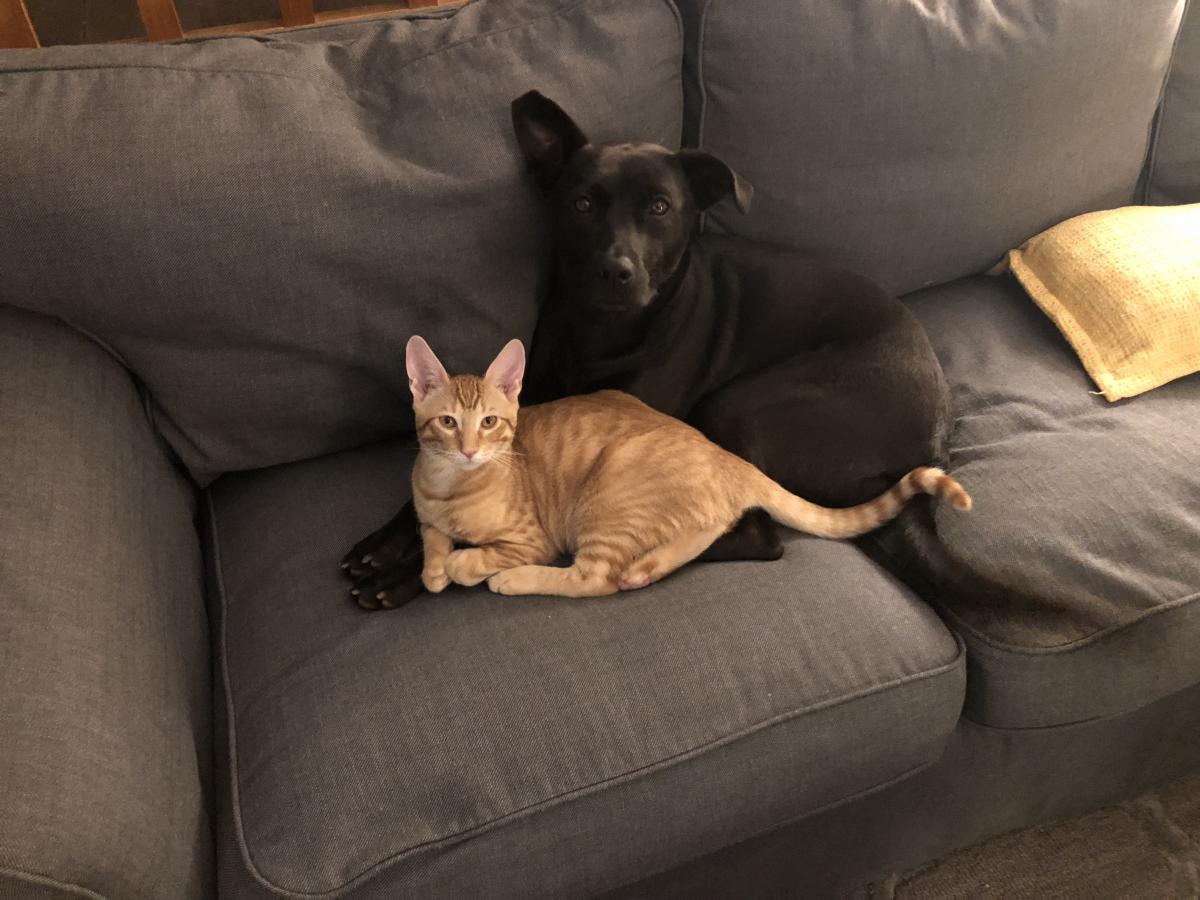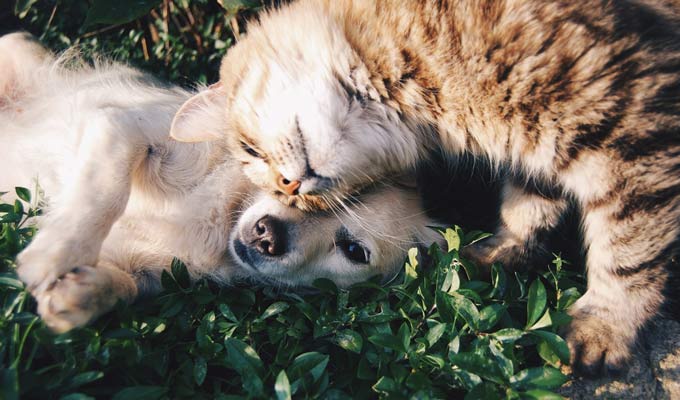Introducing a new dog to a cat is quite tricky. Cultivating a harmonious coexistence of intimacy, camaraderie, and social integration within the shared abode of a dog and a cat is an imperative pursuit. When the decision has been made to introduce a novel canine presence into a feline-occupied realm, the necessity to orchestrate an introduction brimming with tact and finesse becomes undeniable. This strategic approach, like the first brushstrokes on a canvas, sets the tone for an environment steeped in tranquility and mutual understanding.
The tableau of domestic bliss unfurls its vibrant hues when the inhabitants – both canine and feline – engage in a mutual dance of friendship, sharing moments of glee and companionship that transcend species boundaries. These creatures, despite their differences, discover the ability to cohabitate harmoniously, often sharing the same living space, resting abode, culinary indulgences, and playthings. The astounding tapestry of their companionship might even unfold in captivating scenes where the dog emerges as the cat’s valiant guardian, rescuing it from the specter of imminent danger or stealthy predators, and vice versa. Together, they might embark on outdoor escapades, venturing on shared strolls, or settle onto a singular chair to partake in the mesmerizing world of televised entertainment.
In this discourse, we delve into the nuanced art of introducing a new dog to an existing cat, a process that unveils a symphony of mingling scents, cautious curiosity, and tentative camaraderie.
The foundation of this enchanting bond rests upon the cornerstone of socialization. Particularly when introducing a new dog to a resident cat, this process stands as a pivotal juncture where a delicate equilibrium must be achieved. The intention is to curate a scenario where both entities recognize the potential for harmonious cohabitation, where the tapestry of their interactions is woven with threads of mutual respect and serene companionship.
This narrative of coexistence and friendship is not an inevitability. Like any delicate masterpiece, it requires the guiding hand of human intervention. In some instances, the process of introducing a cat to a new dog unfolds naturally, where both parties, guided by their inherent temperaments, forge an immediate connection marked by tranquility and amicability.
Yet, the canvas of reality is diverse, and not every encounter is marked by instant camaraderie. As the new dog is introduced to the cat, the subtleties of their interaction may necessitate careful observation and guidance. With a steady hand, the narrative of their coexistence can be delicately woven, ensuring a tale of shared companionship that resonates with harmony and mutual understanding.

Introducing a new dog to a cat
Guiding the canine and feline ambassadors into this unfolding chapter involves meticulous orchestration. It is a strategic performance in which scents become the brushstrokes that color the canvas of their introduction. The dog’s olfactory curiosity is met with the cat’s cautious intrigue, an intricate choreography of investigative sniffs and tentative steps. In these moments, the essence of their budding companionship is captured—a symphony of mingling odors, inquisitive gazes, and the dance of cautious camaraderie. Let’s find below some tips on introducing a new dog to a cat:
1. A Prelude of Acquaintance
The overture of familiarity commences, marking the dawn of a journey in which a new dog and a resident cat embark on the path of coexistence. This echo of introduction unfolds over a span of 2 to 3 weeks, an orchestration guided by the interplay of temperament, breed lineage, personalities, behavioral inclinations, and the unique environment they inhabit. It is an endeavor rife with exceptions, where the canvas of closeness and affinity may be painted within mere moments, a tapestry woven by the nuances of their identities. Herein lies the complexity—some dogs seamlessly merge into the fabric of a particular feline’s realm, while the same may not hold true for others.
- GPS cat, dog, and Pet trackers
- Build Your Dog Box. 1 Box Every 3 MonthsBuild Your Cat Box. 1 Box Every 3 Months
- Litter Boxes for Your Lovely Kitten On Amazon
- Toilet Training Kit for Your Cute Cat On Amazon
- Cat Health Supplies on Amazon
- Cat Food Supplies on Amazon
- Cat Scratching Posts for Indoor Cats
2. Monitor body language
As the narrative of the introduction unfolds, attuning oneself to the intricate lexicon of body language becomes an indispensable skill. The narrative of their initial encounter is told through the eloquent gestures of both pets. Should the cat’s ears adopt a telltale backward tilt or its tail undulate in rhythmic swishes, these signals are a declaration of discord within the feline’s realm. These telltale signs resonate with hostility, serving as testaments to the cat’s initial reluctance to embrace its newfound companion.
Simultaneously, the dog’s demeanor warrants scrutiny—a vigilant gaze brimming with predatory intent is a harbinger of impending strife. The presence of prey drive in the dog’s gaze serves as an ominous omen, a flicker of the predator’s intentions as it hovers over the prospect of a lower entity succumbing to its predatory prowess.
However, a ray of optimism breaks through the mosaic of potential conflict when the two gazes lock upon each other, albeit without sustained fixation. A hopeful glimmer emerges when they engage each other’s gaze without becoming ensnared within its grasp. Yet, even as their initial interaction evolves, vigilance remains paramount. The ensuing days unveil new scenarios, where their camaraderie may manifest differently, unfettered by human presence.
3. Introduce each other
The overture of their acquaintance unfolds within the bounds of that pivotal first encounter, an introduction that charts the course for their coexistence. In this elaborate ballet of introductions, multiple approaches await consideration, adaptable to the nuances of each unique circumstance. Vigilance is indispensable even when both the dog and the cat have previously shared living quarters with their counterparts. Moreover, an audience of additional individuals is requisite during this performance—one per creature, facilitating swift intervention in the face of unforeseen adversities.
4. The Elixir of Desensitization
A remedy known as desensitization becomes the balm for a dog’s unyielding fixation upon the cat. This elixir involves placing the cat in a secluded space, visible to the dog yet tantalizingly out of reach. The confines of this visual encounter are confined to specific windows of time, preventing any intrusive intrusion on the cat’s domain.
Rest is separated by rooms—a room for the dog, another for the cat, realms that exist in parallel. Each realm is equipped with essentials: litter boxes, toys, sustenance, and more. In this intricate dance of cohabitation, their worlds intertwine through the barriers of scent and the shared symphony of existence. With each passing day, a gradual evolution unfolds, as the olfactory threads of their shared experience weave a tapestry of familiarity and acceptance, uniting their minds in an orchestrated symphony.
Amidst this narrative, the notes of caution resound—the crescendo of their engagement should never waver into disharmony or inflict harm upon each other. Should the aura of disappointment or resentment loom as they inch closer, coercion is an unwise path to traverse. Prioritize their safety above all else, for it is the sanctum of security that lays the foundation of this introduction.

5. The Nexus of Confrontation
As the narrative advances, the two protagonists are led to the same room, a battleground of potential camaraderie or rivalry. The presence of a second individual, integral in this intricate pas de deux, serves to oversee and manage the proceedings. One individual observes the cat’s reactions, ready to intervene should hostile signals arise, while the other tends to the dog’s response.
This confrontation is a nuanced discourse. The cat’s raised back or hissing may serve as clarion calls of resistance, igniting a need for immediate intervention. Should the cat’s reluctance persist, an alternative course of action may beckon.
Notwithstanding, if the dog directs its attention elsewhere, engaged in pursuits unrelated to the feline presence, a favorable sign emerges, a herald of unity. A positive outcome is also signaled if the cat, undeterred by the dog’s proximity, exhibits positive gestures—exploring its surroundings or engaging in other activities.
6. The Ballet of Mutual Disregard
Guiding the dog into the art of not incessantly gazing upon the cat is akin to molding the clay of their interactions. The masterstroke lies in redirecting the dog’s gaze when it lingers upon the feline presence. For this deviation from the norm, a reward is bestowed—a token of acknowledgment for the diversion of focus. This cycle repeats, paving a pathway to acclimatization. Over time, this reward-based approach imprints upon the dog’s consciousness, guiding it to a state of habitual inattention.
- Cat Water Fountain on Amazon
- Cat Carrier on Amazon
- Cat Automatic Feeders on Amazon
- Cat Guide Book on Amazon
- Cat Breed Book on Amazon
- Cat Behavior Book on Amazon
- Cat Training Book on Amazon
- Cat behavior Products on Amazon
- Cat Breed Test
7. Revelations within the Realm of Training
A more intricate chapter in their journey unfolds through the methodology of Look at That (LAT) training—a saga wherein the dog’s gaze transcends the cat’s presence to engage other elements of the environment. As the dog’s gaze oscillates between the cat and its surroundings, it ushers forth a crescendo of transformation. Eventually, the cat’s demeanor transforms, as it graciously turns a blind eye to the dog, reserving attention only for the sound of its name—a tribute to their evolving camaraderie.
The parameters of this phase are fluid, contingent upon the dog’s breed temperament, intrinsic body language, and behavioral traits. The span between them oscillates between 5 and 25 feet, a journey of proximity navigated with the compass of sensitivity.
8. Clicker of verbal marker
A new chapter unfolds a chapter that stretches beyond the previous pages, extending its tendrils into uncharted territory. Within this chapter, the expanse between them expands, widening its embrace to encompass a range of 15 to 20 feet, as if setting the stage for the emergence of new protagonists—clickers and verbal markers—into the intricate narrative. As the dog’s gaze discovers its feline counterpart, a symphony takes shape, a symphony orchestrated by the harmonious interplay of a clicker’s crisp sound or the resonance of a verbal marker. A moment of anticipation dawns—the crux of the matter hinges upon the dog’s response to this auditory cue. A pivotal decision looms in its gaze; if it redirects its attention toward the source of the sound, the curtains rise on an overture of reward.
This elaborate process manifests as a recurring recital, a musical composition that unfolds in waves of success and progress. Each distinct note—the click or marker—serves as an ethereal baton guiding the dog’s focus, directing its gaze to its conductor. With each repetition, the nuances of understanding are etched onto their shared consciousness, a testament to the profound power of transformation that lies within their grasp.

Mistakes to Avoid When Introducing Cats and Dogs
The endeavor of adding a new member to your furry family necessitates thoughtful contemplation and meticulous preparation. Amidst the enthusiasm and anticipation, whether you’re embarking on the journey of being a brand new pet parent or expanding your pack, the question of introducing a fresh feline or canine companion to your resident pets occupies a central space in your mind.
Even the most amiable dogs and cats require a transition period to adjust to a new addition, and the initial stages of this process might bear the weight of stress. Nonetheless, a carefully orchestrated introduction can prove to be a beacon of solace, reducing the anxiety of both pets and fostering an environment where shared space becomes a realm of harmony. In your pursuit to forge a seamless path, steering clear of certain pitfalls can preserve tranquility while your pet family flourishes.
1. The Impatience of Hastening Introductions
Whether you’re stepping into the shoes of a cat parent contemplating the adoption of a dog or a dog aficionado eagerly welcoming a cat into your fold, the journey of successful introductions is an intricate tapestry woven through multiple stages. Your newly acquired pet, like a budding character in a novel, requires the nurturing embrace of time to acclimate to its surroundings. Simultaneously, the resident pet must navigate the terrain of accepting a new presence within their territory.
- Buy Cat Accessories on Amazon
- The Complete Guide to Adopting a Cat: Preparing for, Selecting, Raising, Training, and Loving Your New Adopted Cat or Kitten
- Amazon Best Sellers: Best Cat Training
- Amazon Best Sellers: Best Pet Cats
- Amazon Best Sellers: Best Cat Care
- Amazon Best Sellers: Best Cat Care & Health
- Amazon Best Sellers: Best Cat Breeds
- Cat Products for Indoor Cats
- Cat Toys for Indoor Cats Best Sellers
- Surprise Subscription Boxes for Cool Cat On Amazon
Even if your cat possesses a natural affinity for canines or your dog is acquainted with feline companions, the wise course of action refrains from jumping into a face-to-face meeting at the outset. Instead, orchestrate separate spaces within your dwelling for both pets during the initial days. This segregation allows them to familiarize themselves with each other’s scent, building a foundation for future encounters. The art of feeding both pets on opposite sides of the same door acts as a bridge, connecting them through positive associations.
In an ideal scenario, a tacit understanding dawns upon both pets—a realization that their newfound companionship merits acknowledgment yet unfolds without immediate confrontation. Observe vigilantly for signs of your dog’s fixation on the cat. Recognize the bark, the whine, the scratch of impatience against the door, the deep growl, or the intense gaze fixated upon the barrier separating them. Exercise patience until any obsessive behaviors subside, replaced by an aura of familiarity and acclimatization to the cat’s presence. Only then should the curtains rise on face-to-face introductions.
2. Allowing Autonomy: The Pinnacle of Shared Space
As your pets gradually traverse the expanse of common areas within your home, ensure that they both possess an escape route. The sanctuary of personal space, established during the initial introduction, should remain intact. Honor their need for respite and retreat, a sacred right they must retain as they acclimate to their newfound companionship.
Uphold the safe havens you instituted for your kitty and pup during their initial days under the same roof. These sanctuaries grant solace, empowering them to navigate common spaces while knowing an escape route lies within reach. Felines, often inclined towards high perches and lofty nooks, might find solace on a cat tree or perch. In their elevated vantage points, they lounge and observe, maintaining their boundaries while coexisting in shared spaces.
3. A Symphony of Personalities: The Heartbeat of Cohabitation
The size and strength disparity between most dog breeds and the average house cat often engenders apprehension in pet parents. The specter of dog aggression looms large, with dogs that possess a high prey drive potentially posing a threat to cats. On the flip side, some dogs, propelled by sheer exuberance, might inadvertently play too vigorously and inadvertently cause harm to a feline friend.
It’s equally pivotal to recognize that certain cats might exhibit aggression towards dogs without any provocation. The core essence of your pets—imbued within their unique personalities—acts as the determining factor for whether they can coexist harmoniously with a newcomer.
Intertwined interactions demand close supervision, not just during introductions but also in the weeks that unfurl thereafter. If your dog lunges, growls, or displays any inclination to pin down your cat, it should not be left alone. While specialized training might eventually pave the way for harmonious cohabitation, it’s essential to acknowledge that certain dogs and cats might inherently resist each other’s presence. In such scenarios, the beacon of safety must be prioritized.

4. Unfamiliar Terrain: The Paradox of Introducing Cats and Dogs
A common misconception is that introducing cats and dogs on neutral territory serves as a gateway to successful interactions. This strategy, seemingly logical, often crumbles under the weight of reality. The premise that a fresh environment sets the stage for accurate predictions about their future interactions at home often yields a counterintuitive outcome.
The initial meeting in an alien setting does little to mirror their interactions within the comfort of their home. In reality, this arrangement paradoxically heightens anxiety. The pet that would have found solace within their home environment is thrust into an unfamiliar, unsettling situation. Grant the resident pet the privilege of their familiar abode, affording both pets ample time and space to define their boundaries. Initiate interactions cautiously and in short bursts, allowing the cat and dog to navigate the shared space, step by measured step.
- Buy Bird Accessories on Amazon
- Buy Cat Accessories on Amazon
- Buy Dog Accessories on Amazon
- Buy Fish Accessories on Amazon
- Buy Pet Accessories on Amazon
5. The Unskipped Tune of Vet Visits
Common viruses may distinguish themselves as unique to either cats or dogs, yet parasites such as roundworms, tapeworms, ringworms, and fleas transcend species boundaries. A preemptive visit to your veterinarian, prior to embracing a new pet, ensures the ensemble remains up-to-date on preventatives and vaccinations.
Armed with meticulous planning and foresight, the harmony within your expanding family of pets can flourish, a melody resonating with contentment and vitality.
A concluding remark
Amidst the tapestry of this introduction’s evolution, flexibility emerges as an unwavering cornerstone, a compass calibrated to navigate the intricacies woven by the threads of age and maturity. A cautious approach becomes a loyal companion when weaving the threads of a young kitten’s burgeoning curiosity with the seasoned wisdom of a mature dog’s encounters. Similarly, entwining the innocence of a fledgling puppy with the seasoned wisdom of a weathered cat’s perceptions demands prudence.
A dearth of presence does not grant immunity to the currents of vigilance; it should adorn each chapter of their unfolding engagement, each interaction a reminder that patience unfurls as a sovereign force within the realm of training. Within the canvas of this transformative journey, bear in mind the offerings of treats, a symphony of gratitude that resonates through each lesson. It’s imperative that the melody of training remains interwoven with the notes of kindness and respect. Amidst this harmonious orchestration, let the resonance of harsh voices and punitive actions find no place, for they are discordant notes within the sanctified realm of companionship and mutual understanding.



